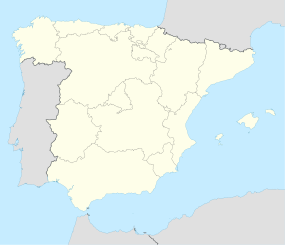Carteia

Roman forum in Carteia.
|
|
| Location | San Roque, Province of Cádiz, Andalusia, Spain |
|---|---|
| Coordinates | 36°11′08″N 5°24′30″W / 36.185524°N 5.408301°WCoordinates: 36°11′08″N 5°24′30″W / 36.185524°N 5.408301°W |
| Type | Settlement |
| History | |
| Founded | 940 BC |
| Cultures |
Phoenician Carthaginian Roman |
| Site notes | |
| Condition | Partially excavated remains |
| Public access | Yes |
Carteia was a Phoenician and Roman town at the head of the Bay of Gibraltar in Spain. It was established at the most northerly point of the bay, about halfway between the modern cities of Algeciras and Gibraltar, overlooking the sea on elevated ground at the confluence of two rivers. According to Strabo, it was founded around 940 BC as the trading settlement of Kʿrt (meaning "city" in the Phoenician language; compare Carthage and Cartagena). The area had much to offer a trader; the hinterland behind Carteia, in the modern south of Andalusia, was rich in wood, cereals, oranges, lemons, lead, iron, copper and silver. Dyes were another much sought-after commodity, especially those from the murex shellfish, used to make the prized Tyrian purple.
The town's strategic location meant that it played a significant role in the wars between Carthage and the Roman Republic in the 2nd and 3rd centuries BC. It may have been the site of Hamilcar's landing with his army and elephants in 237 BC, and in 206 BC the Carthaginian admiral Adherbal retreated there with the remnants of his fleet after being defeated by Gaius Laelius in the Battle of Carteia. Around 190 BC, the town was captured by the Romans.
Livy records that in 171 BC, the Roman Senate was petitioned by a group of Romano-Spanish people, the sons of Roman soldiers and Spanish women. Although they were of Roman descent they were not regarded as Roman citizens, nor were they allowed to marry Roman citizens. The Senate responded by elevating Carteia to the status of a colonia (Roman colony) and granting around 4,000 Romano-Spanish people the right to live there and receive a grant of land on a similar basis to Roman colonists. The existing inhabitants were permitted to remain there, while all of the inhabitants were given the right to marry Roman citizens and to carry on trade with Romans. This marked a significant innovation for Rome's overseas colonies; the Carteians were the first outside Italy to receive a civic status known as the Latin Rights, half-way between being a non-citizen provincial and a full Roman citizen. Other cities in Spain were later granted a similar status.
...
Wikipedia

